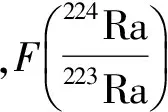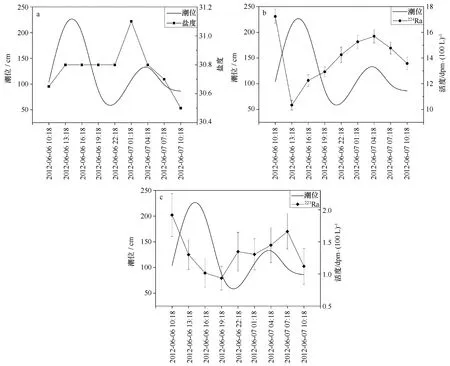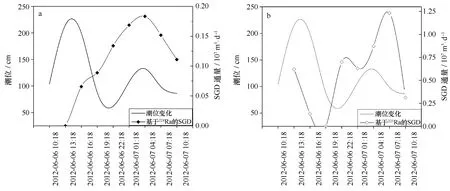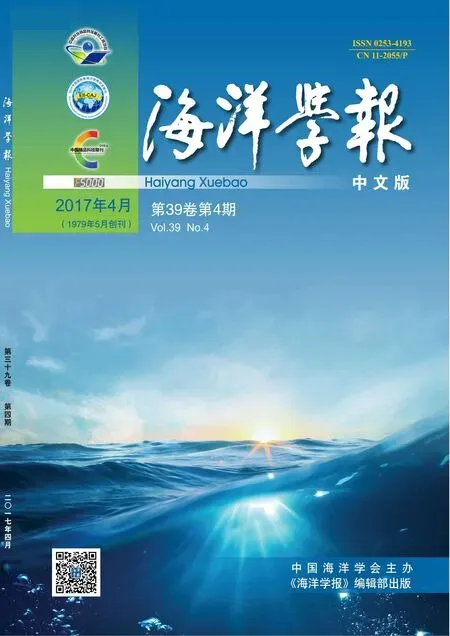基于223Ra和224Ra的桑沟湾海底地下水排放通量
王希龙,杜金洲*,张经
(1.华东师范大学 河口海岸学国家重点实验室,上海 200062)
基于223Ra和224Ra的桑沟湾海底地下水排放通量
王希龙1,杜金洲1*,张经1
(1.华东师范大学 河口海岸学国家重点实验室,上海 200062)
海底地下水排放(SGD)是陆地向海洋输送水量和营养物质的重要通道之一,对沿海物质通量及其生物地球化学循环有重要的影响,对生态环境起着不可忽视的作用。本文运用天然放射性同位素223Ra和224Ra示踪估算了我国北方典型养殖基地桑沟湾的海底地下水排放通量。结果表明,海底地下水样尤其是间隙水中Ra活度[224Ra=(968±31) dpm/(100 L),223Ra=(31.4±4.9) dpm/(100 L),n=9]远高于表层海水[224Ra=(38.7±2.0) dpm/(100 L),223Ra=(1.70±0.50) dpm/(100 L),n=21]。假设稳态条件下,考虑Ra的各源、汇项,利用Ra平衡模型,估算出桑沟湾SGD排放通量为(0.23~1.03)×107m3/d。潮周期内的观测结果显示,涨潮时,水力梯度较小,SGD排放变弱,落潮时,水力梯度较大,导致了相对较多的SGD排放。在一个潮周期间,基于223Ra和224Ra得到的SGD排放通量平均为0.39×107m3/d。潮汐动力下的SGD排放平均占总SGD排放的61%,因此桑沟湾沿岸的地下水排放主要受潮汐动力的影响,并对海水组成及海陆间物质交换有显著贡献。
镭同位素;海底地下水排放;镭库模型;潮汐动力;桑沟湾
1 引言
人类活动影响对近海海域生态系统的主要表现之一就是陆海相互作用过程,而海底地下水排放(submarine groundwater discharge, SGD)是陆海相互作用过程中重要而往往容易被忽视的重要一环。SGD是全球水循环系统中重要的过程之一,由于地下水中的许多成分(如硝酸盐)浓度与海水相比高出许多倍,SGD可能成为沿岸海域营养物质的重要载体和输运途径。同时,通过SGD携带的物质可以改变近海营养物质的组成和结构,从而改变传统的沿岸海域的生物地球化学循环模式[1—3]。
自然界中存在4种天然放射性镭同位素,226Ra(T1/2=1 600 a)、228Ra(T1/2=5.7 a)、224Ra(T1/2=3.7 d)和223Ra(T1/2=11.4 d)。目前这4种天然放射性镭同位素已经被广泛应用于SGD的研究中[4—10]。虽然我国SGD的研究起步较晚,但是相关工作在我国的三大河口及典型海湾都有所涉及[11—20]。
桑沟湾位于山东省东部沿海(37°01′~37°09′N, 122°24′~122°35′E),是我国北方典型的养殖基地,北、西、南三面为陆地环抱,湾口向东,为半封闭型海湾(图1)。桑沟湾水域广阔,海湾面积163.2 km2,海底地势平坦,由西向东逐渐倾斜,坡度较小,平均水深7~8 m,最大水深15~17 m[21]。桑沟湾沿岸无大河注入,入湾的较大河流有桑沟河、崖头河、沽河、小落河等,年平均径流总量为(1.7~2.3)×108m3,年输沙量为17.1×104t。

图1 桑沟湾地理位置(左)及采样站位图(右),大面站、地下水和河水样品采集于2015年5月,连续观测样品采集于2012年6月Fig.1 Location of Sanggou Bay (left) and the station locations in the Sanggou Bay (right): surface water, submarine groundwater, and river water were collected in May 2015; samples for time series station were collected in June 2012
桑沟湾的潮汐类型为不正规半日潮,平均大、小潮差分别为1.47 m和0.57 m,最大潮差可达2.61 m。同时桑沟湾气候温和湿润,变化幅度较小,月平均降水量为68.02 mm。湾内水体温度变化范围较小,年平均水温13℃左右,盐度变化不大,年平均盐度为31.76,1月份最低,6月份最高,盐度变化受黄海沿岸流及降水的影响较为显著[22]。
作为我国典型立体示范养殖区,历史上,桑沟湾的水产资源十分丰富,在渔业生产旺季时,曾有网产青鱼数万斤的记录。自1957年在该湾推广海带筏式养殖生产技术以来,桑沟湾的水产活动走上了以养为主、养捕结合的道路。但是由于对该湾水产资源的管理还存在不合理的地方,使得湾内的水动力情况及陆源物的输入受到较大的影响。此前对于2012年桑沟湾SGD通量及其对营养盐收支平衡的评估已有报道[23],本文则是在此基础上,利用短半衰期核素223Ra和224Ra对桑沟湾的SGD进行再评估,并强调潮汐动力对SGD的影响。
2 采样及实验方法
2015年5月20日至27日期间,利用当地船只根据养殖生物的不同分区,以潜水泵采集桑沟湾表层水体样品,样品采集体积约60 L;同时进行了桑沟湾沿岸地下井水(民用井)、沙滩间隙水和河流样品的采集,地下井水样品的采集体积为20 L,沙滩间隙水的采集体积为10 L,河流样品的采集体积为40 L。所有的样品均用于测定其中的224Ra和223Ra比活度,采样站位如图1所示。对于表层海水样品和周围的河流水样,采用孔径0.5 μm的滤芯进行过滤除去水样中的悬浮颗粒物,地下井水和沙滩间隙水样品采用孔径0.45 μm的醋酸纤维滤膜进行过滤。同时,2012年6月6日至7日在桑沟湾的南部定点(图1中SGTS站)进行了27 h的连续观测,每3 h采一次样品,采样及处理方法同上。

3 结果
3.1 桑沟湾223Ra和224Ra的活度分布
224Ra和223Ra的活度分布如图2所示。此处224Ra的活度值是指在测定的总224Ra活度中减掉其母体228Th的贡献获得的224Ra活度。表层水体中224Ra的活度范围为18.9~81.9 dpm/(100 L),平均为(38.7±16.7) dpm/(100 L) (n=21);223Ra的活度范围为0~2.89 dpm/(100 L),平均为(1.62±0.76) dpm/(100 L) (n=21)。在表层水体的活度分布等值线图中可以看出224Ra和223Ra的活度均表现出明显的近岸高、离岸低的趋势,但在研究区域的东北部均存在一个小幅的活度增长趋势,推测这部分相对高的活度值可能来自桑沟湾以北的爱莲湾的贡献。爱莲湾位于山东半岛最东端,与桑沟湾相邻(图1),同样是养殖型海湾,在气候条件和海洋环境上与桑沟湾相同,但是桑沟湾为半封闭型海湾,爱莲湾则相对开阔,与外海的交换也更充分[26],因此,此处的高值可能来自爱莲湾的陆源输入。此外,在图1中站位SG-3、SG-9、SG-10、SG-11、SG-15处分别采集了底层水体样品,其表、底层水体中224Ra和223Ra的活度列于表1中。从表1中可以看出,桑沟湾的浅水区(水深低于8 m)水体在垂向上基本混合均匀——水温、盐度和Ra的活度均没有明显的变化;在水深较深的SG-3站位处,测得的表层水体中224Ra比底层稍高,但是水温和盐度的变化并不大。
海底地下水样品(井水和沙滩间隙水)的采样结果同样显示在图2中。从图中可以看出海底地下水样品中的Ra活度变化范围较大。井水样品中的224Ra活度范围是38.3~269 dpm/(100 L),平均为(104±73.8) dpm/(100 L) (n=8);223Ra活度范围是0.03~5.36 dpm/(100 L),平均为(2.06±1.85) dpm/(100 L) (n=8)。岸边沙滩间隙水中224Ra和223Ra的活度[224Ra:116~2 003,(968±653) dpm/(100 L);223Ra:1.78~50.9,(26.2±17.8) dpm/(100 L),n=9]则比井水高近10倍。

图2 桑沟湾表层海水224Ra(a)和223Ra(b)活度等值线图及海底地下水(实心圆)、河流中(空心圆)的活度图Fig.2 Contour plots of 223Ra and 224Ra in the surface water of Sanggou Bay, and dots plots for submarine groundwater (filled circles) and river water (open circle) around Sanggou Bay
表1 桑沟湾部分站位的表、底层水的温、盐和镭活度
Tab.1 Temperature, salinity and Ra activities in several stations of Sanggou Bay

站位水深/m层次水温/℃盐度224Ra误差223Ra误差dpm·(100L)-1SG⁃318 2表13 530 522 41 50 980 28底11 431 516 00 90 840 26SG⁃99 7表1531 943 42 21 010 34底14 231 940 41 71 080 38SG⁃109 1表16 231 440 41 71 920 60底15 931 332 82 30 760 33SG⁃118 5表--42 62 11 550 54底--34 62 63 430 99SG⁃158 0表17 131 236 11 62 080 63底16 131 436 61 81 310 46

图3 2015年5月表层水体(a)、地下井水(b)、间隙水(c)和河流(d)中224Ra vs. 223Ra及其相关性数据Fig.3 Plots of 224Ra vs. 223Ra for all samples, surface water (a), groundwater (b), pore water (c) and river water (d). The results of correlation analysis were also shown in the plots
3.2 同位素比值
近岸水体中Ra同位素的主要来源有河流沉积物的解吸和含盐地下水的排放[5,27]。从沉积物上释放之后,224Ra和223Ra不断通过吸附在沉积物上的Th同位素的衰变产生,但是这种输入在一个较长的时间必然达到稳定。对于224Ra和223Ra来讲,即使具有相同的来源也会因为输入过程中的衰变而产生不同的活度比。图3显示了224Ra与223Ra在不同水体中的比值。从图3中可以看出表层水体、地下井水、间隙水和河水中224Ra与223Ra之间的线性拟合直线斜率分别为20.9 (r=0.94,P<0.01,n=21)、39.7 (r=0.88,P<0.01,n=8)、31.8 (r=0.93,P<0.01,n=9)和16.8 (r=0.91,P<0.01,n=5),并表现出显著的线性相关性。与地下水(井水和沙滩间隙水)相比,桑沟湾表层水体中的活度比值较低,这可能是由于地下水中224Ra不断地由母体产生,而当其进入海水后,母体的贡献减小,224Ra不断衰变造成的。而与表层水体相比,河水中的224Ra与223Ra的活度及其比值均较低,因此表层水体中的224Ra/223Ra活度比(AR).很可能是由于Ra同位素在通过地下水向海输入过程中的衰变造成的。
4 讨论
4.1 桑沟湾水体表观年龄
水体表观年龄可以用来描述水体的迁移扩散过程,是了解水体及其物质在海洋中输送的水动力过程的基础[28-29]。要估算桑沟湾的海底地下水排放通量,也必然要先得到桑沟湾水体的停留时间。天然存在的Ra同位素,基于一个短半衰期和一个长半衰期核素的活度比可用于确定近岸水体的表观年龄[30]。近岸水体中Ra的添加项主要来自河流、沉积物以及地下水的输入,Ra的损失项则主要由与低Ra活度水体的混合及其自身放射性衰变造成。假设系统处于稳态,那么基于Moore等[30]的方法,针对224Ra和223Ra可以写出如下平衡方程:
(1)
(2)
式中,F224Ra和F223Ra分别代表输入系统的224Ra和223Ra的总通量;I224Ra和I223Ra分别代表系统中224Ra和223Ra的总量;λ224和λ223分别代表224Ra和223Ra的衰变常数,分别为0.189 d-1和0.060 8 d-1;τ代表系统的水体表观年龄。用公式(1)除以公式(2)可以得到:
(3)
将公式(3)整理并求解水体表观年龄τ,可以得到:
(4)

(5)
式中,V是桑沟湾的平均水体体积,12.2×108m3;Q=P/T,P是潮周期内的纳潮量,为3.74×108m3,T是1个潮周期的时间,为0.517 d;In在这里代表河流对桑沟湾的净输入量,为5.48×105m3/d;b则代表回流因子,即外海水在研究区域内的贡献比例[30],基于水体、盐度和226Ra的三端元混合模型,可以得到b=0.743[23]。因此,可以估算出桑沟湾的水体冲刷时间为6.56 d,与本研究结果在误差范围内基本一致。因此,本研究中采用t=6.1 d作为桑沟湾水体滞留时间。
4.2 过剩Ra库的估算
桑沟湾表层水体中短半衰期核素224Ra和223Ra的主要源、汇项包括河流输入、与外海水的混合、自身的衰变、沉积物的贡献以及SGD的输入等。我们先前的研究表明,黄海对桑沟湾的水体贡献比例平均为0.743,并且黄海水体中224Ra的平均活度为4.99 dpm/(100 L),223Ra则为0.20 dpm/(100 L)[23],由此可以得出桑沟湾表层水体中每个站位的过剩223Ra和224Ra。由于桑沟湾水体水深较浅,平均为7.5 m,因此我们采用表层水体中的Ra活度代表整个水柱中的Ra活度,结合桑沟湾的水域面积和平均水深,可以得到过剩223Ra和224Ra库分别为1.80×1010和4.28×1011dpm。结合上述桑沟湾的水体滞留时间,可以获得其过剩223Ra和224Ra通量分别为2.95×109和7.02×1010dpm/d。类似地,对于河流输入的Ra通量,采用先前获得的河流的贡献比(0.045)[23]乘以河流端元样品的Ra活度[223Ra=0.64 dpm/(100 L),224Ra=8.95 dpm/(100 L)]和河流的径流量[(1.7~2.3)×108m3/a[21],本文采用中间值2.0×108m3/a],即河流输入的223Ra和224Ra通量分别为1.58×105和2.21×106dpm/d。由此可见,相对于前述桑沟湾过剩通量,河流的贡献可以忽略。
对于桑沟湾水柱中的Ra来讲,底层沉积物孔隙中Ra的向上扩散是其另一个可能的来源。为了估算桑沟湾底层沉积物的贡献,我们根据公式(6)对Ra的最大扩散通量进行了估算[33]:
(6)
式中,Fdif表示底层沉积物的释放通量,单位dpm/d;Ds表示镭在沉积物中的扩散系数,一般根据镭在水体中的扩散系数与沉积物的孔隙度求得[34—35],此处取4.0×10-6cm2/s;Kd表示分布系数(80),A为研究区域的水域面积(1.63×108m2);对于224Ra考虑其母体228Th的贡献,但由于223Ra的母体227Th的半衰期较短(18.7 d),227Th的母体227Ac虽然半衰期较长(21.8 a),但在海水表层沉积物中的活度未曾有报道,因此对于表层沉积物中228Th的活度采用黄海的表层沉积物报道值(4.418 Bq/g)[36],再根据沙滩间隙水中的224Ra/223Ra活度比(42.8)对沉积物贡献的223Ra进行估算,分别得到沉积物贡献的224Ra通量为2.1×108dpm/d,223Ra通量为4.8×106dpm/d。与上述桑沟湾的过剩通量结果相比,沉积物贡献的223Ra和224Ra小2~3个数量级,此值更印证了Wang等[23]的报道中沉积物的贡献可以忽略这一结论。值得一提的是尽管温度等环境因素可能会影响镭同位素在沉积物和水体中的扩散,但变化范围不可能达到2~3个数量级,因此,此处并未考虑温度等参数对扩散系数的影响。由于223Ra和224Ra的半衰期较短,其自身衰变是不可忽略项,衰变损失项可由实测Ra库值和衰变系数及上述水体滞留时间算得,分别为1.01×109dpm/d和5.31×1010dpm/d。因此以上述过剩Ra通量减去河流、沉积物的贡献和衰变量,即可得到由SGD贡献的223Ra和224Ra通量,分别为1.94×109dpm/d和1.71×1010dpm/d。
4.3 SGD的估算
由于近岸水体中的Ra核素不断被外海的低Ra活度海水稀释,所以观测到近岸高值必然来自陆源的贡献[37]。为了计算SGD,先要知道由SGD贡献的过剩223Ra或224Ra和地下水端元中的223Ra或224Ra活度。通过上述计算,SGD输送的223Ra和224Ra的通量已经确定,因此,仅需要确定地下水端元的223Ra和224Ra的活度。既然海底地下水贡献了桑沟湾的过剩223Ra和224Ra,那么地下水端元中的Ra活度必然高于桑沟湾水体中的Ra活度,同时其活度比(AR)必然大于过剩224Ra与223Ra的比值,据此筛选出地下水端元的224Ra的活度范围为127~2 003 dpm/(100 L),平均值为737 dpm/(100 L),223Ra的活度范围为4.06~50.9 dpm/(100 L),平均值为18.9 dpm/(100 L)。将上述算得的SGD输送的223Ra和224Ra通量分别除以地下水端元中的223Ra和224Ra的平均活度,可以得到桑沟湾地区的SGD入海通量为(0.23~1.03)×107m3/d,此值与文献报道的桑沟湾2012年6月的SGD通量[(2.59~3.07)×107m3/d][23]相比略小,可能与示踪剂、季节、降雨以及养殖等存在一定的关系。在先前的报道中采用长半衰期的226Ra和228Ra作为示踪剂估算桑沟湾的SGD排放量,桑沟湾的水体年龄尺度上为数天,对于226Ra和228Ra来讲,其衰变可以忽略;本研究中采用半衰较短的223Ra和224Ra作为示踪剂,尽管海底地下水的采样都选在最接近海湾的位置甚至在退潮时的沙滩,但确实存在一定的衰变影响,因此本研究得到的SGD结果在一定程度上低估了桑沟湾的SGD排放。总结荣成地区的降雨量信息可以发现,不管是在年代较远的1959—1980年[21]还是在1981—2010年(中国气象数据网),一年当中5月的降水量始终比6月少,有时甚至仅有6月的1/2,进而通过降水造成的5月地下径流比6月也少,从而SGD排放中淡水部分相对减少。此外,受到桑沟湾海水养殖活动的影响,5月海带开始收获,6月(夏季)海带基本收获完毕,水体流动性加强[38],风浪及潮汐作用下SGD的排放也可能会相应变快。
4.4 潮汐动力下的桑沟湾SGD的估算
4.4.1 潮周期内Ra同位素的释放通量
在近岸海湾、河口等地区,潮汐作用通常会成为影响近岸水体与外海交换的一个重要因素。为了评价桑沟湾地区潮汐作用对SGD输送的影响,本文于2012年6月6日至7日在桑沟湾南部(37°3′18″N, 122°31′42″E)的鱼排上进行了27 h潮周期内连续的定点观测,每3 h采一次样品,样品的采集及处理方法与上述相同。观测期间盐度从低潮时的30.5变化到高潮时的31.1。同样地,Ra同位素的活度也表现潮周期内的浮动变化,与盐度变化相反,表现为在高潮时活度较低而在低潮时活度较高(图4)。这与高潮时带有较低Ra活度的外海水进入桑沟湾,低潮退出时带入沿岸的高活度Ra有关。

图4 桑沟湾水体盐度(a)、224Ra (b)和223Ra (c)活度在潮周期内的变化情况Fig.4 The tidal level condition and the measured salinity (a), 224Ra (b), 223Ra (c) activities of Sanggou Bay during time series sampling
在潮汐作用下,Ra同位素在海湾内的交换过程可以表示为:
(7)

(8)
其中水体的交换量可以表示为:
Wexch=A×H×n,
(9)

4.4.2 潮汐动力下的SGD排放通量
考虑到桑沟湾Ra同位素的源汇,以及潮周期定点采样的弊端,为了更合理的评估桑沟湾潮汐动力下的SGD排放通量,我们采用如下公式进行计算[15]:
(10)
式中,Ratotal是潮周期内的测得的每一个样品的Ra活度,Rabkgd是外海Ra活度的背景值,为了规避潮汐外的其他影响因素,以潮周期内Ra活度的最低值作为此背景值,同样地为了避免偶然性的影响将第一个最高值去掉,h是水深,A是海湾的面积,τ是水体滞留时间,Ragw是地下水端元中的Ra活度。由于Ratotal是基于连续站观测的每一个时间点的Ra的活度,因此就能够产生一系列的SGD输入通量(图5)。对于224Ra和223Ra,可以分别得到潮汐动力下SGD的排放通量分别为(0.07~0.18)×107和(0.14~1.23)×107m3/d,平均值分别为0.13×107m3/d和0.64×107m3/d。此结果与2012年6月基于表层水样的计算结果相比略小,与上述2015年5月基于Ra库的结果相差不大,这反映了桑沟湾在雨量较少的春季,潮汐动力对于SGD的排放起着至关重要的作用。需要指出的是与长半衰期核素相比,短半衰期核素对环境变化比较敏感,且测量误差较大,会对结果造成一定的影响。因此,上述结果存在较大范围的浮动。

图5 基于潮周期内224Ra (a)和223Ra (b)得到的SGD通量的周期变化Fig.5 SGD variation during the tidal cycle based on 224Ra (a) and 223Ra (b)
由于不同的地理环境和沿岸沉积物的各项异性,SGD通量在空间上变化很大,这一点在仅就我国沿岸海域及小海湾的SGD研究就可以看出(表2)。从北到南,Ma等[41]和Wang等[42]对莱州湾的SGD和SFGD(地下淡水排放)进行了研究发现莱州湾洪季的SFGD和SGD的通量分别相当于黄河年径流量的0.57~0.88以及7.35~8.57倍。郭占荣等[12-14]分别运用Ra和Rn同位素先后评价了福建省隆教湾、九龙江河口和五缘湾的SGD通量,其中九龙江地区的地下水输入量是河流径流量的4倍多。Wang等[43]对海南三亚湾珊瑚礁系统的SGD进行了研究,发现SGD是海南三亚湾近岸水体酸化的重要诱因。以上研究表明对于近岸海域尤其是封闭半封闭的小海湾的SGD的研究是十分必要的,SGD对于类似的小海湾的生态环境具有不可忽略的影响。
4.5 SGD估算的不确定性分析

5 结论
通过我国典型立体养殖区——桑沟湾的海水、地下水和河流样品中短半衰期核素224Ra和223Ra的分布规律对春季桑沟湾的水体滞留时间和SGD排放通量进行了研究,发现桑沟湾的水体滞留时间平均为6.1 d;运用Ra库模型示踪估算得到2015年5月桑沟湾的SGD排放通量为(0.23~1.03)×107m3/d,尽管这一SGD通量存在着40%~62%的不确定度,但是这一通量预示着通过SGD排放的重要物质通量可能会对桑沟湾的生源要素的收支平衡具有重要影响。此外,潮周期内的连续观测表明,桑沟湾Ra同位素的交换量分别是2.57×1010(224Ra)和0.40×1010dpm/d (223Ra),相应SGD排放通量的平均值分别为0.13×107和0.64×107m3/d。对比发现,尽管多种驱动力促使着SGD的排放,但是在桑沟湾这样一个半封闭的养殖型海湾中,潮汐动力发挥着重要的作用。
[1] Johannes R E. The ecological significance of the submarine discharge of groundwater[J]. Marine Ecology Progress Series, 1980, 3(4): 365-373.
[2] Maher D T, Santos I R, Golsby-Smith L, et al. Groundwater-derived dissolved inorganic and organic carbon exports from a mangrove tidal creek: the missing mangrove carbon sink[J]. Limnology and Oceanography, 2013, 58(2): 475-488.
[3] Kwon E Y, Kim G, Primeau F, et al. Global estimate of submarine groundwater discharge based on an observationally constrained radium isotope model[J]. Geophysical Research Letters, 2014, 41(23): 8438-8444.
[4] Webster I T, Hancock G J, Murray A S. Use of radium isotopes to examine pore-water exchange in an estuary[J]. Limnology and Oceanography, 1994, 39(8): 1917-1927.
[5] Rama, Moore W S. Using the radium quartet for evaluating groundwater input and water exchange in salt marshes[J]. Geochimica et Cosmochimica Acta, 1996, 60(23): 4645-4652.
[6] Hancock G J, Webster I T, Ford P W, et al. Using Ra isotopes to examine transport processes controlling benthic fluxes into a shallow estuarine lagoon[J]. Geochimica et Cosmochimica Acta, 2000, 64(21): 3685-3699.
[7] Krest J M, Harvey J W. Using natural distributions of short-lived radium isotopes to quantify groundwater discharge and recharge[J]. Limnology and Oceanography, 2003, 48(1): 290-298.
[8] Beck A J, Rapaglia J P, Cochran J K, et al. Radium mass-balance in Jamaica Bay, NY: evidence for a substantial flux of submarine groundwater[J]. Marine Chemistry, 2007, 106(3/4): 419-441.
[9] Colbert S L, Hammond D E. Shoreline and seafloor fluxes of water and short-lived Ra isotopes to surface water of San Pedro Bay, CA[J]. Marine Chemistry, 2008, 108(1/2): 1-17.
[10] Moore W S, Beck M, Riedel T, et al. Radium-based pore water fluxes of silica, alkalinity, manganese, DOC, and uranium: a decade of studies in the German Wadden Sea[J]. Geochimica et Cosmochimica Acta, 2011, 75(21): 6535-6555.
[11] 黄磊. 九龙江河口区的地下水输入研究[D]. 厦门: 厦门大学, 2009.
Huang Lei. Research on groundwater discharge into Jiulongjiang Estuary[D]. Xiamen: Xiamen University, 2009.
[12] 郭占荣, 黄磊, 刘花台, 等. 镭同位素示踪隆教湾的海底地下水排泄[J]. 地球学报, 2008, 29(5): 647-652.
Guo Zhanrong, Huang Lei, Liu Huatai, et al. The estimation of submarine inputs of groundwater to a coastal bay using radium isotopes[J]. Acta Geoscientica Sinica, 2008, 29(5): 647-652.
[13] 郭占荣, 黄磊, 袁晓婕, 等. 用镭同位素评价九龙江河口区的地下水输入[J]. 水科学进展, 2011, 22(1): 118-125.
Guo Zhanrong, Huang Lei, Yuan Xiaojie, et al. Estimating submarine groundwater discharge to the Jiulong River estuary using Ra isotopes[J]. Advances in Water Science, 2011, 22(1): 118-125.
[14] 郭占荣, 李开培, 袁晓婕, 等. 用氡-222评价五缘湾的地下水输入[J]. 水科学进展, 2012, 23(2): 263-270.
Guo Zhanrong, Li Kaipei, Yuan Xiaojie, et al. Assessment of submarine groundwater discharge into the Wuyuan Bay via continuous Radon-222 measurements[J]. Advances in Water Science, 2012, 23(2): 263-270.
[15] Peterson R N, Burnett W C, Taniguchi M, et al. Radon and radium isotope assessment of submarine groundwater discharge in the Yellow River delta, China[J]. Journal of Geophysical Research, 2008, 113(C9): C09021.
[16] Tse K C, Jiao J J. Estimation of submarine groundwater discharge in Plover Cove, Tolo Harbour, Hong Kong by222Rn[J]. Marine Chemistry, 2008, 111(3/4): 160-170.
[17] Su Ni, Du Jinzhou, Moore W S, et al. An examination of groundwater discharge and the associated nutrient fluxes into the estuaries of eastern Hainan Island, China using226Ra[J]. Science of the Total Environment, 2011, 409(19): 3909-3918.
[18] Gu Hequan, Moore W S, Zhang Lei, et al. Using radium isotopes to estimate the residence time and the contribution of submarine groundwater discharge (SGD) in the Changjiang effluent plume, East China Sea[J]. Continental Shelf Research, 2012, 35: 95-107.
[19] Liu Q, Dai M, Chen W, et al. How significant is submarine groundwater discharge and its associated dissolved inorganic carbon in a river-dominated shelf system[J]. Biogeosciences, 2012, 9(5): 1777-1795.
[20] Ji Tao, Du Jinzhou, Moore W S, et al. Nutrient inputs to a Lagoon through submarine groundwater discharge: the case of Laoye Lagoon, Hainan, China[J]. Journal of Marine Systems, 2013, 111-112: 253-262.
[21] 夏东兴, 王文海, 刘传信, 等. 中国海湾志·第三分册·山东半岛北部和东部海湾·第九章[M]. 北京: 海洋出版社, 1991.
Xia Dongxing, Wang Wenhai, Liu Chuanxin, et al. The Journal of Chinese Gulf-The Third Section: Bays of the Northern and Eastern Shandong Peninsula-Chapter 9[M]. Beijing: China Ocean Press, 1991.
[22] 毛兴华, 张为先, 张建中. 桑沟湾增养殖环境综合调查研究[M]. 青岛: 青岛出版社, 1988.
Mao Xinghua, Zhang Weixian, Zhang Jianzhong. The Comprehensive Investigation of Aquaculture in Sanggou Bay[M]. Qingdao: Qingdao Press, 1988.
[23] Wang Xilong, Du Jinzhou, Ji Tao, et al. An estimation of nutrient fluxes via submarine groundwater discharge into the Sanggou Bay-a typical multi-species culture ecosystem in China[J]. Marine Chemistry, 2014, 167: 113-122.
[24] Moore W S. Sampling228Ra in the deep ocean[J]. Deep-Sea Research and Oceanographic Abstracts, 1976, 23(7): 647-651.
[25] 谷河泉, 杜金洲, 吴梅桂, 等. 镭延迟符合计数器(RaDeCC)测量海水中的224Ra和223Ra[J]. 海洋环境科学, 2015, 34(4): 570-577.
Gu Hequan, Du Jinzhou, Wu Meigui, et al. Precise determination of224Ra and223Ra in seawaters By RaDeCC[J]. Marine Environmental Science, 2015, 34(4): 570-577.
[26] 李磊, 任景玲, 刘素美, 等. 桑沟湾溶解态无机砷的分布、季节变化及影响因素[J]. 环境科学, 2014, 35(7): 2705-2713.
Li Lei, Ren Jingling, Liu Sumei, et al. Distribution, seasonal variation and influence factors of dissolved inorganic arsenic in the Sanggou Bay[J]. Environmental Science, 2014, 35(7): 2705-2713.
[27] Moore W S. Radium-228 in the south Atlantic bight[J]. Journal of Geophysical Research, 1987, 92(C5): 5177-5190.
[28] Dronkers J, Zimmerman J T F. Some principles of mixing in tidal lagoons //Lasserre P, et al. (Ed.) Coastal lagoons: Proceedings of the international symposium on coastal lagoons, Bordeaux, France, 8-14 September 1981[J]. Oceanologica Acta, 1982, 4(S): 107-117.
[29] Monsen N E, Cloern J E, Lucas L V, et al. A comment on the use of flushing time, residence time, and age as transport time scales[J]. Limnology and Oceanography, 2002, 47(5): 1545-1553.
[30] Moore W S, Blanton J O, Joye S B. Estimates of flushing times, submarine groundwater discharge, and nutrient fluxes to Okatee Estuary, South Carolina[J]. Journal of Geophysical Research, 2006, 111(C9): C09006, doi: 10.1029/2005JC003041.
[31] Sanford L P, Boicourt W C, Rives S R. Model for estimating tidal flushing of small embayments[J]. Journal of Waterway, Port, Coastal, and Ocean Engineering, 1992, 118(6): 635-654.
[32] Wang Guizhi, Wang Zhangyong, Zhai Weidong, et al. Net subterranean estuarine export fluxes of dissolved inorganic C, N, P, Si, and total alkalinity into the Jiulong River estuary, China[J]. Geochimica et Cosmochimica Acta, 2015, 149: 103-114.
[33] Krest J M, Moore W S, Rama.226Ra and228Ra in the mixing zones of the Mississippi and Atchafalaya Rivers: indicators of groundwater input[J]. Marine Chemistry, 1999, 64(3): 129-152.
[34] 蔡立胜, 方建光, 董双林. 桑沟湾养殖海区沉积物-海水界面氮、磷营养盐的通量[J]. 海洋水产研究, 2004, 25(4): 57-64.
Cai Lisheng, Fang Jianguang, Dong Shuanglin. Preliminary studies on nitrogen and phosphorus fluxes between seawater and sediment in Sungo Bay[J]. Marine Fisheries Research, 2004, 25(4): 57-64.
[35] Li Yuanhui, Gregory S. Diffusion of ions in sea water and in deep-sea sediments[J]. Geochimica et Cosmochimica Acta, 1974, 38(5): 703-714.
[36] 洪华生. 中国区域海洋学——化学海洋学[M]. 北京: 海洋出版社, 2012.
Hong Huasheng. Regional Oceanography of China Seas-Chemical Oceanography[M]. Beijing: China Ocean Press, 2012.
[37] Moore W S. Seasonal distribution and flux of radium isotopes on the southeastern U.S. continental shelf[J]. Journal of Geophysical Research, 2007, 112(C10): C10013.
[38] 陈聚法, 赵俊, 孙耀, 等. 桑沟湾贝类养殖水域沉积物再悬浮的动力机制及其对水体中营养盐的影响[J]. 海洋水产研究, 2007, 28(3): 105-111.
Chen Jufa, Zhao Jun, Sun Yao, et al. Dynamic mechanism of sediment resuspension with its effects on content of nutrients in water in the shellfish culture area of Sanggou Bay[J]. Marine Fisheries Research, 2007, 28(3): 105-111.
[39] Garcia-Orellana J, Cochran J K, Bokuniewicz H, et al. Time-series sampling of223Ra and224Ra at the inlet to Great South Bay (New York): a strategy for characterizing the dominant terms in the Ra budget of the bay[J]. Journal of Environmental Radioactivity, 2010, 101(7): 582-588.
[40] 杜鹏. 夏季桑沟湾三维水质数值模拟[D]. 青岛: 中国海洋大学, 2009.
Du Peng. The three-dimensional water quality numerical simulation in Sanggou Bay in summer[D]. Qingdao: Ocean University of China, 2009.
[41] Ma Qian, Li Hailong, Wang Xuejing, et al. Estimation of seawater-groundwater exchange rate: case study in a tidal flat with a large-scale seepage face (Laizhou Bay, China)[J]. Hydrogeology Journal, 2015, 23(2): 265-275.
[42] Wang Xuejing, Li Hailong, Jiao J J, et al. Submarine fresh groundwater discharge into Laizhou Bay comparable to the Yellow River flux[J]. Scientific Reports, 2015, 5: 8814.
[43] Wang Guizhi, Jing Wenping, Wang Shuling, et al. Coastal acidification induced by tidal-driven submarine groundwater discharge in a coastal coral reef system[J]. Environmental Science & Technology, 2014, 48(22): 13069-13075.
[44] Kim G, Ryu J W, Yang H S, et al. Submarine groundwater discharge (SGD) into the Yellow Sea revealed by228Ra and226Ra isotopes: implications for global silicate fluxes[J]. Earth and Planetary Science Letters, 2005, 237(1/2): 156-166.
[45] Wu Zijun, Zhou Huaiyang, Zhang Shuai, et al. Using222Rn to estimate submarine groundwater discharge (SGD) and the associated nutrient fluxes into Xiangshan Bay, East China Sea[J]. Marine Pollution Bulletin, 2013, 73(1): 183-191.
[46] Xu Bochao, Burnett W, Dimova N, et al. Hydrodynamics in the Yellow River Estuary via radium isotopes: ecological perspectives[J]. Continental Shelf Research, 2013, 66: 19-28.
[47] Wen Tingyu, Du Jinzhou, Ji Tao, et al. Use of222Rn to trace submarine groundwater discharge in a tidal period along the coast of Xiangshan, Zhejiang, China[J]. Journal of Radioanalytical and Nuclear Chemistry, 2014, 299(1): 53-60.
[48] Luo Xin, Jiao J J, Moore W S, et al. Submarine groundwater discharge estimation in an urbanized embayment in Hong Kong via short-lived radium isotopes and its implication of nutrient loadings and primary production[J]. Marine Pollution Bulletin, 2014, 82(1/2): 144-154.
[49] Xia Dong, Yu Zhigang, Xu Bochao, et al. Variations of hydrodynamics and submarine groundwater discharge in the Yellow River Estuary under the influence of the water-sediment regulation scheme[J]. Estuaries and Coasts, 2016, 39(2): 333-343.
Submarine groundwater discharge into Sanggou Bay traced by223Ra and224Ra
Wang Xilong1, Du Jinzhou1, Zhang Jing1
(1.StateKeyLaboratoryofEstuarineandCoastalResearch,EastChinaNormalUniversity,Shanghai200062,China)
Submarine groundwater discharge (SGD) with inputs of nutrients and water into the ocean in certain regions plays a significant role in coastal material fluxes and their biogeochemical cycle, which cannot be ignored for its impact on the eco-system. In this paper, SGD into the typical aquaculture base of northern China, Sanggou Bay, was estimated using naturally occurring radium isotopes,223Ra and224Ra. Results showed that the radium activities of submarine groundwater, especially in the pore water [224Ra=(968±31) dpm/(100 L),223Ra=(31.4±4.9) dpm/(100 L),n=9], were obviously greater than those in the surface water [224Ra=(38.7±2.0) dpm/(100 L),223Ra=(1.70±0.50) dpm/(100 L),n=21]. Assuming steady state and using a radium mass balance model with sources and sinks, the SGD rate was estimated to be among (0.23~1.03) ×107m3/d. SGD flux varied from spring tide to ebb tide. During spring tide, SGD flux was smaller because of weak hydraulic gradient while it was much larger during ebb tide because of strong hydraulic gradient. During a tidal cycle, the SGD flux was averaged to be 0.39×107m3/d based on223Ra and224Ra. Tidal-driven SGD can account for 61% of the total SGD. Therefore, the main driving force of SGD into Sanggou Bay was tidal pumping and SGD of Sanggou Bay in coastal zone contributes a lot to seawater composition and material exchange between land and sea.
radium isotopes; submarine groundwater discharge; balance model; tidal pumping; Sanggou Bay
10.3969/j.issn.0253-4193.2017.04.002
2016-05-08;
2016-11-28。
科技部973项目“多重压力下近海生态系统可持续产出与适应性管理的科学基础”(2011CB409801);国家自然科学基金项目“我国黄海海底地下水排泄及营养盐入海通量的研究”(41376089)。
王希龙(1989—),女,山东省聊城市人,博士研究生,从事海洋同位素化学方向研究。E-mail:xuanfeng698547@126.com
*通信作者:杜金洲,男,教授,从事同位素海洋学和环境放射化学的研究。E-mail:jzdu@sklec.ecnu.edu.cn
P734.2
A
0253-4193(2017)04-0016-12
王希龙,杜金洲,张经. 基于223Ra和224Ra的桑沟湾海底地下水排放通量[J].海洋学报,2017,39(4):16—27,
Wang Xilong, Du Jinzhou, Zhang Jing. Submarine groundwater discharge into Sanggou Bay traced by223Ra and224Ra[J]. Haiyang Xuebao,2017,39(4):16—27, doi:10.3969/j.issn.0253-4193.2017.04.002

